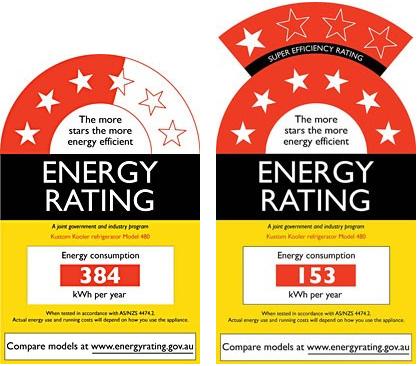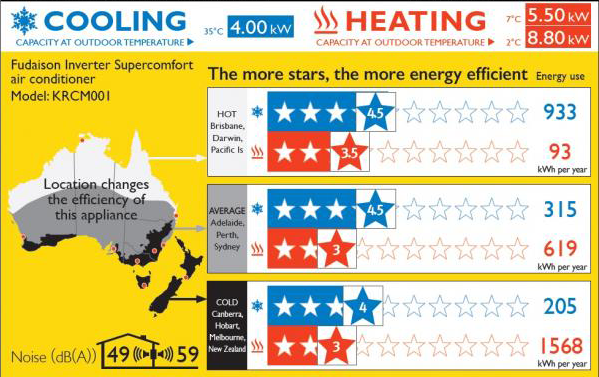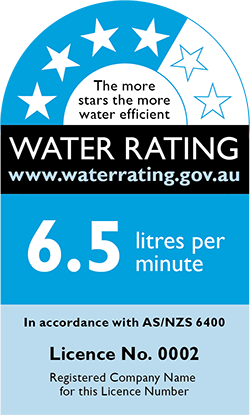When it comes to your monthly electricity bill, the energy efficiency of your appliances remains one of the biggest factors in determining its size. Having one inefficient appliance may not seem like a big deal. But what happens when you have a household full of them?
We’ve all heard how buying the most energy-efficient appliances helps to protect the environment and our back pockets. But what do energy star ratings actually mean? And is an appliance with a high energy star rating really going to save you money in the long run?
Find out everything you need to know about energy star ratings in this Canstar Blue guide.

What are the energy star ratings?
Energy star ratings are an initiative designed to help consumers work out an appliance’s energy efficiency. They show an appliance’s energy rating on a six- or 10-star scale, as well as its annual energy consumption (measured in kWh per year). Energy star ratings are mandatory for a number of household appliances, including dishwashers, washing machines, fridges and TVs.
Energy star ratings come in whole- or half-star increments. The rating is determined by energy service per unit of energy consumption, and the lower the energy consumption, the higher the star rating. Generally, you’ll see the standard six-star rating label.
Is a six-star energy rating the best?
When the energy star rating labels were first introduced, the highest efficiency rating an appliance could get was six stars. In recent years, though, the ratings have been expanded, with super-efficient appliances now scoring between seven and 10 stars.
These super-efficient appliances have a slightly different label and are worth keeping an eye out for if you’re after the most efficient appliances for your home.

Heat pump energy star ratings explained
On your journey to find an efficient appliance, you may find that heat pumps have a blue-and-red energy star rating label.
The blue energy star labels indicate how efficient the model is at cooling. The red energy star label indicates how efficient the heat pump is when heating.
Furthermore, heat pumps imported from July 2021 display the new Zoned Energy Rating Label (ZERL). This lists energy efficiency in New Zealand and Australia, giving a more accurate measurement than before.
How are energy star ratings calculated?
In New Zealand, the Energy Efficiency and Conservation Authority (EECA) administers label compliance.
The energy star ratings are determined by the size of the product and its energy consumption levels, and products are compared to similarly sized alternatives. This information is then run through algorithms to create nationwide standards.
An appliance with a high energy star rating indicates that it does its job efficiently. Meaning that it can generally run at a cheaper price than an appliance with a lower efficiency rating. So your monthly bills should be cheaper.
But whether that means it will save you money isn’t as clear cut, as more than just running costs affect the bottom line.
Efficient appliances may save you money over the long run through cheaper electricity bills. But, generally, they come with a higher initial cost. So it’s generally a trade-off as to whether you want to save money upfront by purchasing a less-efficient appliance, or save money in the long run by purchasing a more efficient product.
Take the below example, which compares two 420L fridges:
- Model 1 has a 2.5-star energy rating, costs $1299 to purchase and uses 468kW of energy per annum, with an approximate running cost of $117 per year.
- Model 2 has a 4-star energy rating, costs $1377 to purchase and uses 328kW of energy per annum, with an approximate running cost of $79.50 per year.
Although Model 1 may save you $78 in terms of its initial purchase cost, over a year it will cost you around $37.50 more in running costs.
If you go with Model 2, you will have made your money back after three years. And, assuming that your fridge lasts for the average lifespan of 14 years, you stand to save over $400 in terms of running costs and electricity bills over that period.
However, keep in mind this is a rough estimate, and the efficiency of every appliance will vary. As will the purchase price and the price each individual pays for power. However, it does demonstrate that there are savings to be had by purchasing more energy-efficient appliances.
But remember, it’s not all about savings. You may prefer paying more upfront to lower your monthly bill stings. Or, you may just see value in reducing your carbon footprint.
→Related article: Energy-efficient Appliances: the True Costs of Energy Star Ratings Revealed!
Compare power providers
Energy-efficient appliances are a great way to save on power. But, if your paying too much for the power itself, then you’re not getting the best deal.
A great way to start finding the best power provider is by checking out Canstar’s latest Star Ratings awards, which rate NZ power companies for customer satisfaction and value for money. See the table below for some of the results, or click on the button below for the full results of our survey.
Canstar Blue’s latest review of NZ power companies compares them on customer satisfaction. The table below is an abridged version of our full results, available here.
^ By clicking on a brand or 'details' button, you will leave Canstar Blue and be taken to either a product provider website or a Canstar Blue NZ brand page. You agree that Canstar Blue NZ’s terms and conditions apply (without limitation) to your use of this service,to any referral to a product provider from our website, and any transaction that follows. Canstar Blue may earn a fee for referrals from its website tables, and from sponsorship (advertising) of certain products. Payment of sponsorship fees does not influence the star rating that Canstar Blue awards to a sponsored product. Fees payable by product providers for referrals and sponsorship may vary between providers, website position, and revenue model. Sponsorship fees may be higher than referral fees. Sponsored products are clearly disclosed as such on website pages. They may appear in a number of areas of the website such as in comparison tables, on hub pages and in articles. Sponsored products may be displayed in a fixed position in a table, regardless of the product’s rating, price or other attributes. The table position of a sponsored product does not indicate any ranking, rating or endorsement by Canstar Blue. See How we are funded for further details.
Canstar Blue NZ Research finalised in April 2023, published in June 2023.
See Our Ratings Methodology
How should I use the energy star ratings in my decision?
An energy star rating should be a key part of your buying decision. Not only will it future-proof your appliance, ensuring low ongoing costs. But an energy efficient appliance is also good for the environment. While most of New Zealand’s energy comes from renewable sources, using less energy is still beneficial.
However, make sure that when comparing energy star ratings you:
- Compare star ratings on appliances that are the same type, size and capacity
- Use your own individual power costs and average usage to get a better indication of annual costs

What about the Water Star Ratings?
Appliances that use water, such as dishwashers and washing machines, also feature water star ratings alongside energy star ratings. Other appliances (that don’t use energy) such as showerheads and toilets may have a standalone water efficiency label.
Like an energy label, the Water Efficiency Labelling Scheme indicates the water efficiency of the appliance through a star rating and by showing litres per minute the appliance uses.
If purchasing an appliance that uses both water and electricity, you will have to weigh up both the energy use and water use, which may add another layer of complexity to your decision.
Compare appliances with Canstar Blue

About the author of this page
This report was written by Canstar Content Producer, Andrew Broadley. Andrew is an experienced writer with a wide range of industry experience. Starting out, he cut his teeth working as a writer for print and online magazines, and he has worked in both journalism and editorial roles. His content has covered lifestyle and culture, marketing and, more recently, finance for Canstar.
Enjoy reading this article?
You can like us on Facebook and get social, or sign up to receive more news like this straight to your inbox.
By subscribing you agree to the Canstar Privacy Policy


Share this article